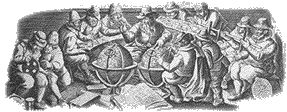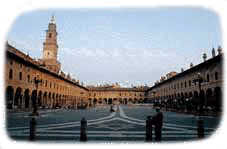 Itineraries
Itineraries



Ducal Square It was opened from 1492 to 1494 in the centre of the medieval village as a court of honour to the Castle. Ludovico il Moro, at that time Governor of Milan, ordered Ambrogio da Corte, the Duke's Chamberlain, to demolish the many houses of the "Contrada Mercatesca" where merchants used to expose their products and build a beautiful square there. In this way the new square entered a medieval urbanistic agglomeration ex novo and without any dimensional conditionings. With the perimetrical arcades it is 134 metres long and 48 metres wide and the fažades of the buildings that delimit it on three sides lean on 84 columns surmounted by capitals all different from one another (12 on the short side and 33 on the two longer sides). The fažades of the buildings decorated in graffito are run through by a band on which alternatively there are cupids and cornucopie, fauns and satyrs. A sequence of medallions is painted amid the columns and represents personages of the classic age and of the Sforza dynasty, old proverbs and particular sayings. The forth side of the square (east) is closed by the fažade of the cathedral in baroque style of the seventeenth century: Saint Ambrogio's. *Originally near the tower the arcades of the square were broken off from the last but four column onwards, to leave room for a carriage ramp flanked with two stairs, which climbed to the castle passing under the base of the tower. In 1680 Bishop Juan Caramuel Lobkowiz started the reconstruction of the square.
In this way the new square entered a medieval urbanistic agglomeration ex novo and without any dimensional conditionings. With the perimetrical arcades it is 134 metres long and 48 metres wide and the fažades of the buildings that delimit it on three sides lean on 84 columns surmounted by capitals all different from one another (12 on the short side and 33 on the two longer sides). The fažades of the buildings decorated in graffito are run through by a band on which alternatively there are cupids and cornucopie, fauns and satyrs. A sequence of medallions is painted amid the columns and represents personages of the classic age and of the Sforza dynasty, old proverbs and particular sayings. The forth side of the square (east) is closed by the fažade of the cathedral in baroque style of the seventeenth century: Saint Ambrogio's. *Originally near the tower the arcades of the square were broken off from the last but four column onwards, to leave room for a carriage ramp flanked with two stairs, which climbed to the castle passing under the base of the tower. In 1680 Bishop Juan Caramuel Lobkowiz started the reconstruction of the square.
1 - The new fažade of the cathedral was built in baroque style to conceal artificially the asymmetry existing between the longitudinal axes of the church and the square. Of the four portals of the fažade, only three concern the church, the forth hides the entry of a public way.
2 - On the south side of the square the access ramp to the Castle was destroyed and the main stair was built; it still exists, hidden by the continuation of the arcades.
3 - The two big semicircular arches leading to Via Giorgio Silva and Via del Popolo, which occupied the space of two arcades, were conformed to the rest of the colonnade. When the work was over the square was so transformed from the court of honour of the Castle into the yard of the Cathedral. The paving was realized in 1836 with the Ticino river stones, while the street-lamps in cast iron for the gas lighting go back to the second half of the century. The tidy look of the roofs, of the chimneys and of the windows are due to a restoration made at the beginning of 1900. Through a legacy of Giorgio Silva a citizen of Vigevano, the wall decoration of the buildings was remade in 1902 by two painters of Vigevano: Casimiro Ottone and Luigi Bocca; they tried to reproduce the scanty remains of decoration of the fifteenth century. Lastly, the statue of Saint John Nepomuceno, a Bohemian saint, was erected in 1731 on order of prince Lichtesten, the commander of the Austrian garrison stationing in the castle.

 |  |
| Back | Home |






 In this way the new square entered a medieval urbanistic agglomeration ex novo and without any dimensional conditionings. With the perimetrical arcades it is 134 metres long and 48 metres wide and the fažades of the buildings that delimit it on three sides lean on 84 columns surmounted by capitals all different from one another (12 on the short side and 33 on the two longer sides). The fažades of the buildings decorated in graffito are run through by a band on which alternatively there are cupids and cornucopie, fauns and satyrs. A sequence of medallions is painted amid the columns and represents personages of the classic age and of the Sforza dynasty, old proverbs and particular sayings. The forth side of the square (east) is closed by the fažade of the cathedral in baroque style of the seventeenth century: Saint Ambrogio's. *Originally near the tower the arcades of the square were broken off from the last but four column onwards, to leave room for a carriage ramp flanked with two stairs, which climbed to the castle passing under the base of the tower. In 1680 Bishop Juan Caramuel Lobkowiz started the reconstruction of the square.
In this way the new square entered a medieval urbanistic agglomeration ex novo and without any dimensional conditionings. With the perimetrical arcades it is 134 metres long and 48 metres wide and the fažades of the buildings that delimit it on three sides lean on 84 columns surmounted by capitals all different from one another (12 on the short side and 33 on the two longer sides). The fažades of the buildings decorated in graffito are run through by a band on which alternatively there are cupids and cornucopie, fauns and satyrs. A sequence of medallions is painted amid the columns and represents personages of the classic age and of the Sforza dynasty, old proverbs and particular sayings. The forth side of the square (east) is closed by the fažade of the cathedral in baroque style of the seventeenth century: Saint Ambrogio's. *Originally near the tower the arcades of the square were broken off from the last but four column onwards, to leave room for a carriage ramp flanked with two stairs, which climbed to the castle passing under the base of the tower. In 1680 Bishop Juan Caramuel Lobkowiz started the reconstruction of the square.


